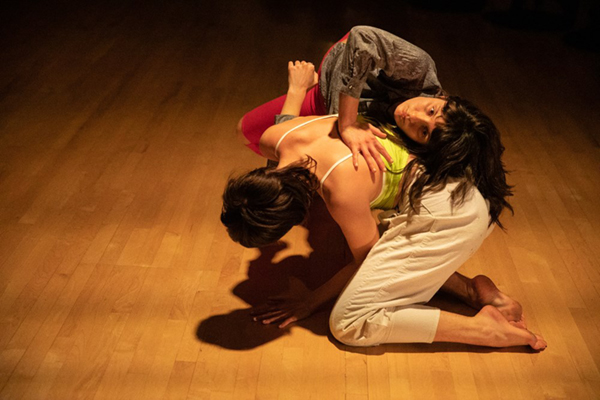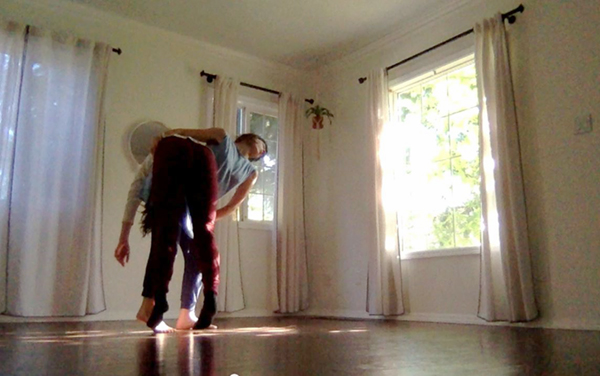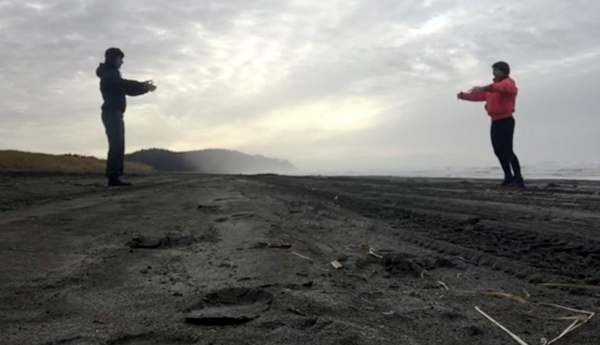Discussing Spirituality, Intimacy, and Power Dynamics
For the past six months, Emily Jones (she/her) and Hannah Krafcik (she/they) have been artists in residence at New Expressive Works (N.E.W.) in Portland, OR, creating their first work, switch, which debuted in March. Here, they each share some of their reflections on this experience, particularly on the role of spirituality, intimacy, practice, and power dynamics in their movement explorations.
switch at New Expressive Works, March 2019, Photo credit: Intisar Abioto
~~
Emily: Prior to this residency Hannah and I had been working together for almost two years, sharing thoughts and practices. We were both drawn to the ritual of practice. We talked a lot about the importance of having a dance practice for our general wellbeing and also about how we both used dance as a tool for personal growth and reflection. I kept coming back to the idea of choreography, trying to put my finger on what was distinct for me and what felt potent. I think, at some point, I just began to see choreography pop up in moments of improvisation, or certain actions that felt resonant would come to me.
I have never really identified as a spiritual or religious person, but our shared commitment to practice led me to wonder if dancing is a sort of spiritual practice for us—one that we, as white Americans, have striven to cultivate in the absence of a sense of connection to the spiritual traditions and practices of our ancestors. At the same time, we wondered if our specific dance lineages could be complicit in spiritual bypassing by failing to acknowledge cultural appropriation and the ways socio-political structures—like patriarchy, racism and heteronormativity—infiltrate their scenes.
We were doing all this unpacking of the dance traditions we are part of—contact improvisation, somatics, contemporary and experimental dance—and our own fraught relationships with them. We asked: Who has power and agency within these practices and forms? We entered into this residency with all these questions stirring in our heads. I think this made us very conscientious about the dynamics between each other as we went into the process.
We had to be thoughtful and careful about power and leadership in the choreographic context. I think this allowed us each to give lots of space to hear where the other person was coming from. We were both really willing to hear each other out and, if something didn’t sit right, we always had the option to shift and change. In that way, it also became a practice of not holding too tightly to anything, but trusting that what unraveled would hold both of us. Ironically, that sort of trust feels very spiritual.
The shaping of our dance has been difficult to track. The movements have emerged from both Hannah and I, and we have been influenced by feedback from a long list of people along the way. The movements in switch arose from some of our earlier conversations but have also morphed in significance since as they are practiced over time. Lately, I have been thinking about abstraction. Our work could easily fall into the category of abstract art, but I keep asking myself: What if what is happening in our performance is what is actually happening? What if Hannah and I are just performing ourselves in this moment?
Living room practice, Photo credit: Hannah Krafcik
~~
Hannah: After our performances at N.E.W., people frequently mentioned the intimacy Emily and I share during switch. Part of that intimacy probably connects to my own performance anxiety and inability to grapple with an audience. When we begin switch, as it stands, we start by looking into each other’s eyes. In this moment, I think to myself, “YOU [Emily]. I can see you seeing me, and that is how I know I am here and that we are actually doing this.”
Underneath our intimacy are our long talks in the studio, and, prior to that, all the time we spent together dancing in my little living room because we needed space and that was space enough. I am reminded of our camping trips to the coast and our meandering discussions about historical trauma, family dynamics, whiteness, ability, queerness and gender confusion. I am reminded of the time we were camping together, and I started my period and stepped in my own sh*t all in one morning. Emily offered me coffee filters and a dog bag to clean up the mess since we did not have any toilet paper. We have seen each other in these complex and gross states, and that messiness is in the work.
We have many points of identification with one another. We are socialized to be good girls and to do whatever the “right thing” is by white, cishet standards. Within these similarities, we have also tracked a sense of antagonism: a shared experience of deep knowing that comes in tandem with inescapable competition and distance. In retrospect, I see us grappling with this in switch by playing on the spectrum of dominant and submissive in our choreography, and by exploring moments of gentleness and care alongside moments of aggression.
The audience container continues to shift and inform our relationship as it plays out in the dance. Right before our showing at N.E.W., something awkward happened in rehearsal. I ended up very panicked out about how our intimate choreography might result in a cocktail of crossed boundaries—for both of us—especially in the close-up performance context we chose with the audience surrounding us. To mitigate this, we talked through the dance, section-by-section, discussing our feelings about each moment. We had very different feelings about certain sections of the dance, and we found that our moments in contact with one another were more fraught and needed more sussing out. That whole episode felt big to me.
Sometimes, I wonder how power dynamics and the quality of relationships show up (maybe more so than intended) in dance works, and so I especially enjoy thinking about switch in these terms. If anything, we have worked hard on our relationship.
On the beach in residency at the Sou’wester Lodge in Seaview, WA, Photo credit: Hannah Krafcik
~~



